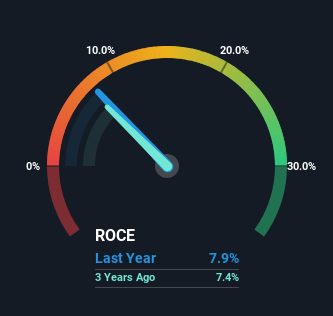- Portugal
- /
- Construction
- /
- ENXTLS:EGL
Returns On Capital Signal Tricky Times Ahead For Mota-Engil SGPS (ELI:EGL)

What trends should we look for it we want to identify stocks that can multiply in value over the long term? Ideally, a business will show two trends; firstly a growing return on capital employed (ROCE) and secondly, an increasing amount of capital employed. Put simply, these types of businesses are compounding machines, meaning they are continually reinvesting their earnings at ever-higher rates of return. However, after briefly looking over the numbers, we don't think Mota-Engil SGPS (ELI:EGL) has the makings of a multi-bagger going forward, but let's have a look at why that may be.
What Is Return On Capital Employed (ROCE)?
For those who don't know, ROCE is a measure of a company's yearly pre-tax profit (its return), relative to the capital employed in the business. To calculate this metric for Mota-Engil SGPS, this is the formula:
Return on Capital Employed = Earnings Before Interest and Tax (EBIT) ÷ (Total Assets - Current Liabilities)
0.079 = €203m ÷ (€6.4b - €3.8b) (Based on the trailing twelve months to December 2022).
Thus, Mota-Engil SGPS has an ROCE of 7.9%. In absolute terms, that's a low return and it also under-performs the Construction industry average of 9.9%.
Check out our latest analysis for Mota-Engil SGPS

Above you can see how the current ROCE for Mota-Engil SGPS compares to its prior returns on capital, but there's only so much you can tell from the past. If you'd like to see what analysts are forecasting going forward, you should check out our free report for Mota-Engil SGPS.
So How Is Mota-Engil SGPS' ROCE Trending?
On the surface, the trend of ROCE at Mota-Engil SGPS doesn't inspire confidence. To be more specific, ROCE has fallen from 9.8% over the last five years. However, given capital employed and revenue have both increased it appears that the business is currently pursuing growth, at the consequence of short term returns. And if the increased capital generates additional returns, the business, and thus shareholders, will benefit in the long run.
On a separate but related note, it's important to know that Mota-Engil SGPS has a current liabilities to total assets ratio of 60%, which we'd consider pretty high. This can bring about some risks because the company is basically operating with a rather large reliance on its suppliers or other sorts of short-term creditors. While it's not necessarily a bad thing, it can be beneficial if this ratio is lower.
Our Take On Mota-Engil SGPS' ROCE
Even though returns on capital have fallen in the short term, we find it promising that revenue and capital employed have both increased for Mota-Engil SGPS. In light of this, the stock has only gained 6.2% over the last five years. Therefore we'd recommend looking further into this stock to confirm if it has the makings of a good investment.
One final note, you should learn about the 3 warning signs we've spotted with Mota-Engil SGPS (including 1 which is a bit concerning) .
For those who like to invest in solid companies, check out this free list of companies with solid balance sheets and high returns on equity.
If you're looking to trade Mota-Engil SGPS, open an account with the lowest-cost platform trusted by professionals, Interactive Brokers.
With clients in over 200 countries and territories, and access to 160 markets, IBKR lets you trade stocks, options, futures, forex, bonds and funds from a single integrated account.
Enjoy no hidden fees, no account minimums, and FX conversion rates as low as 0.03%, far better than what most brokers offer.
Sponsored ContentNew: Manage All Your Stock Portfolios in One Place
We've created the ultimate portfolio companion for stock investors, and it's free.
• Connect an unlimited number of Portfolios and see your total in one currency
• Be alerted to new Warning Signs or Risks via email or mobile
• Track the Fair Value of your stocks
Have feedback on this article? Concerned about the content? Get in touch with us directly. Alternatively, email editorial-team (at) simplywallst.com.
This article by Simply Wall St is general in nature. We provide commentary based on historical data and analyst forecasts only using an unbiased methodology and our articles are not intended to be financial advice. It does not constitute a recommendation to buy or sell any stock, and does not take account of your objectives, or your financial situation. We aim to bring you long-term focused analysis driven by fundamental data. Note that our analysis may not factor in the latest price-sensitive company announcements or qualitative material. Simply Wall St has no position in any stocks mentioned.
About ENXTLS:EGL
Mota-Engil SGPS
Provides public and private construction works and related services in Europe, Africa, and Latin America.
Good value slight.
Similar Companies
Market Insights
Community Narratives


